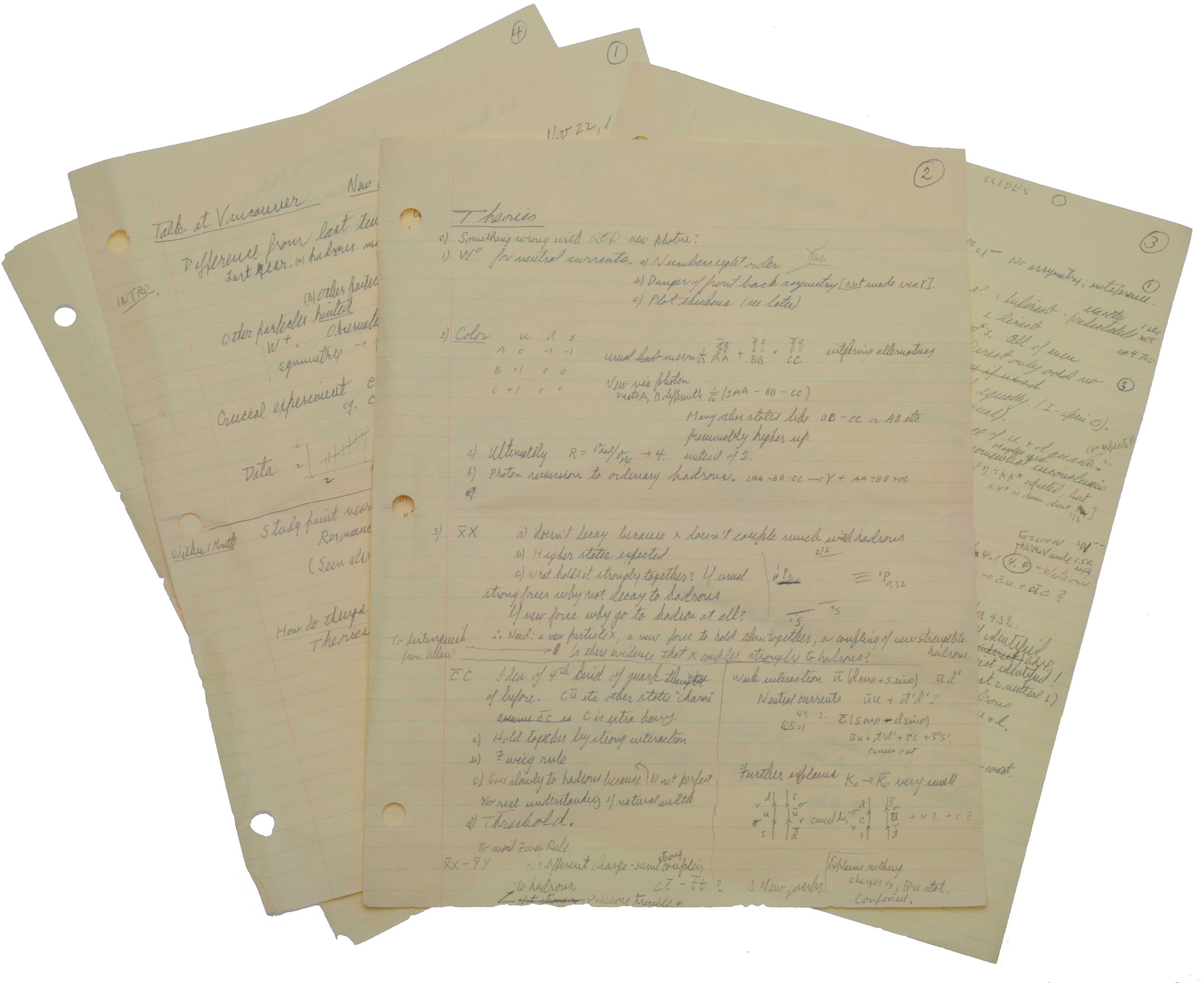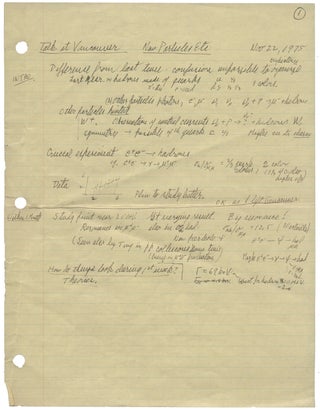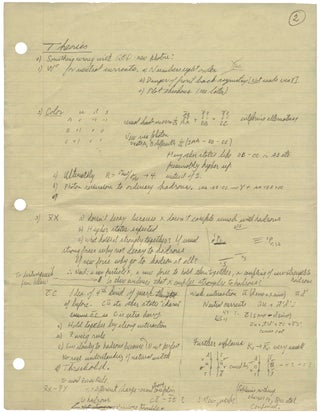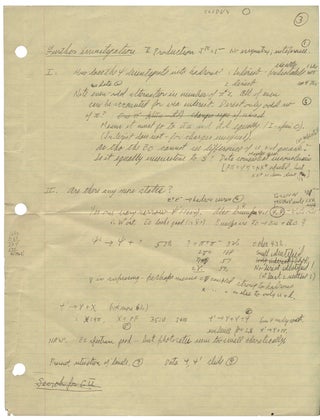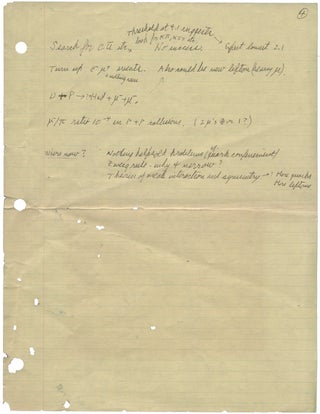Autograph manuscript, unsigned, entitled ‘Talk at Vancouver New Particles etc.’ Vancouver, Canada, 22 November 1975.
Vancouver: [np], 1975. A detailed draft for a talk given to the Canadian Association of Physics Students, in Vancouver, on the contemporary state of subatomic particle physics, its current difficulties and possible future developments. Although a ‘popular’ talk, it is pitched at a high level, appropriate to postgraduate students in physics. Feynman manuscripts with scientific content are very rare on the market – this is one of a small collection of such manuscripts that was retained by Feynman’s family until 2018 when it was consigned to auction. Widely regarded as the most brilliant, influential, and iconoclastic figure in theoretical physics in the post-World War II era, Feynman shared the Nobel Prize in Physics 1965 with Sin-Itiro Tomonaga and Julian Schwinger “for their fundamental work in quantum electrodynamics, with deep-ploughing consequences for the physics of elementary particles.” Feynman refers briefly to a talk given to students in Vancouver in Surely You're Joking Mr. Feynman! (p. 343): ‘In Canada they have a big association of physics students. They have meetings; they give papers, and so on. One time the Vancouver chapter wanted to have me come and talk to them. The girl in charge of it arranged with my secretary to fly all the way to Los Angeles without telling me. She just walked into my office. She was really cute, a beautiful blonde. (That helped; it’s not supposed to, but it did.) And I was impressed that the students in Vancouver had financed the whole thing. They treated me so nicely in Vancouver that now I know the secret of how to really be entertained and give talks: Wait for the students to ask you.’ In fact, Feynman gave more than one talk to the Vancouver students, the offered notes probably referring to the second such talk, for in a letter to Mariela Johansen of April 1975, he writes: ‘I often remember vividly my most enjoyable trip. Many things bring it to mind – like the dark blue T-shirt in my drawer at home – or the interference picture in my office – or just now when my secretary asked me if I wanted to talk to students at a nearby university (USC 20 miles) or high school. My answer was that I will talk to students anytime they are near enough to home, or are at Vancouver, B.C.’ (The Quotable Feynman (2015), p. 296). That these notes probably refer to the second Vancouver talk is confirmed by the first sentence on p. 1, in which Feynman writes: ‘Difference from last time … last year …’ The slides for this talk, which Feynman refers to at one point in these notes, are preserved in the Feynman archives at Caltech. By 1975, what is now called the ‘Standard Model’ of particle physics was close to being established. It provides a ‘unified’ description of three of the four forces through which subatomic particles interact – the electromagnetic, weak and strong forces; the fourth force, gravity, has still not been unified with the other three. In this manuscript, Feynman summarizes the current understanding of the Standard Model in 1975, and discusses several significant ‘loose ends’. Some of these were resolved in the years following his talk, while others are still open today. The first two of the three forces to be ‘unified’ were the weak and electromagnetic. In 1957 Julian Schwinger postulated that three different bosons (particles with whole number spin, that obey Bose-Einstein statistics) must be involved in transmitting the weak force to take account of all the possible different ways the nucleons can interact in the nucleus. Two of these bosons were required to exchange positive and negative charges, now called the W+ and W- (weak) bosons; a third neutral boson, the Z0 (which Feynman calls the W0) was required for reactions in which no charge was transferred. In 1973, ‘neutral weak currents’ (i.e., interactions between particles that involve the exchange of W0 bosons) were observed at CERN, and the electroweak theory became widely accepted. However, the W+, W- and W0 bosons themselves were not observed experimentally until 1983. The theory of the strong force, called quantum chromodynamics (QCD), acquired its modern form in 1973-74. In 1964, Murray Gell-Mann and George Zweig (a student of Feynman) independently postulated that baryons (protons and neutrons) were composed of triplets of very small, strongly interacting, fundamental particles which Gell-Mann called ‘quarks’. It was also predicted that mesons were similarly composed of these same fundamental particles but in the form of quark-antiquark pairs. The proposed quarks had very unusual properties in that their charge had fractional rather than integer values. At the time only three types (also known as flavours) of quarks were known: ‘up, ‘down’ and ‘strange’ (u, d and s) with electric charges 2/3, -1/3, -1/3, respectively. The proton contains 2 up quarks and 1 down quark giving it a total charge of 1; the neutron contains 2 down quarks and 1 up quark giving it a total charge of 0; mesons could be composed of a variety of quark/antiquark pairs such as uu, dd, ud, du and others. Nobody has actually isolated or seen a single individual quark since they are permanently ‘confined’ within observable particles like the proton and neutron from which single quarks cannot escape due to the strong inter-quark (nuclear) force, which holds the particle together. In 1964 Oscar Greenberg pointed out that having two identical quarks in the hadron’s triplet of quarks violated Pauli’s exclusion principle, a basic rule of quantum physics which does not allow a particle to contain more than one quark in the same quantum state. To overcome this problem he suggested that quarks should have three new degrees of freedom. In 1965 Greenberg’s idea was taken up by Moo-Young Han and Yoichiro Nambu who introduced the notion of a quantum ‘colour charge’ with three possible values, red, green or blue; colours can also be positive or negative. Analogous to the electromagnetic force, like-coloured charges repel each other and different-coloured charges attract, but the three colour charges when combined result in a neutral charge. In 1968 evidence of the existence of quarks was confirmed by a team at Stanford Linear Accelerator Center (SLAC). Although quarks are ‘confined’ inside hadrons, they can advertise their presence indirectly by generating jets of particles in high-energy collisions. For example, an electron and positron can annihilate each other creating a quark and antiquark pair. If the collision energy is high enough the quark and antiquark fly apart, degenerating into hadrons such as pions and kaons which are emitted as two ‘jets’ radiating outwards in the same plane from the collision point. In 1974, Burton Richter from SLAC announced the results of his experiments with high-energy electron-positron collisions and, at the same meeting, Samuel Ting from Brookhaven National Laboratory announced the results of his own investigations into the interactions of high-energy protons on a beryllium target. By coincidence both experimenters had produced a stream of new particles with a resonance spike in the number of particles formed with an energy of 3.1 GeV giving the particles a mass of three times the mass of a proton. It turned out that they had independently produced the same new particle, now known as the ‘J/ψ’ particle. Investigations showed that this was a meson consisting of a charm quark and an anticharm quark, the first evidence of the existence of the charm, the fourth quark. The discovery of the J/ψ (and thus the charm quark) ushered in a series of breakthroughs which are collectively known as the ‘November Revolution,’ as it triggered additional searches for unknown elementary particles, explorations that would reveal the final shape of the Standard Model. This was the state of knowledge of particle physics when Feynman stood up to give his talk in November 1975. On page 1 of this manuscript, Feynman begins with a recap of the situation in particle physics when he gave his talk ‘last year’. He recalls that hadrons are made of quarks, which come in three ‘colours’; other known particles include the photon, electron, muon, pions, … The existence of other particles was hinted at: the W-bosons, and a possible fourth quark. Feynman mentions that the crucial experiment would involve the collision of high-energy electrons and positrons, producing hadrons. In 1976 John Ellis, Graham Ross and Mary Gaillard theorised that very high-energy electron-positron collisions would result in three co-planar jets of hadrons. In 1979 these ‘three-jet’ events were detected by the TASSO team working on the PETRA particle accelerator at the Deutsches Elektronen-Synchrotron (DESY) in Hamburg. They provided the first direct experimental evidence for the existence of gluons, the carriers of the strong nuclear force. In the last few lines of this page, Feynman refers to the experiments of Richter and Ting which led to the discovery of the fourth type of quark. On page 2, Feynman discusses the theories of quarks and the colour force in more detail, and in particular the decay of hadrons into other hadrons. He mentions ‘Zweig’s rule’, proposed in the 1960s, which states that when hadrons decay the constituent quarks have to survive (this means that some apparently possible decays of hadrons are actually forbidden). On page 3, Feynman discusses how the J/ψ -particle decays into hadrons. The J/ψ is composed of a charm quark and a charm antiquark. The Zweig rule means that most modes of decay into hadrons are forbidden. This gives the J/ψ-particle a longer lifetime than would otherwise have been expected, and allows it to decay into photons, which then further decay into hadrons, or into electron-positron or muon-anti-muon pairs. On page 4, Feynman speculates that there should be a new lepton (‘heavy muon’). He was proved correct when, in 1975, Martin Lewis Perl and his team experimenting with high-energy electron-positron collisions at SLAC discovered the ‘tau lepton’, the most massive of the lepton family, having a mass about 3,490 times the mass of the electron. Feynman points out that there is still no explanation of quark confinement, or of Zweig’s rule, and speculates that theories of weak interactions may lead to the existence of yet more new quarks and leptons. In this he was proved partially correct: in 1977 scientists at Fermilab discovered the fifth quark, the bottom quark, and in 1995 they discovered the sixth one, the top. To date, however, no further leptons beyond the electron, muon and tau, and their associated neutrinos and anti-particles, have been discovered.
Four pages (280 x 216), in black ballpoint pen on four sheets of yellow lined paper, creases where previously folded.
Item #4859
Price: $32,500.00

